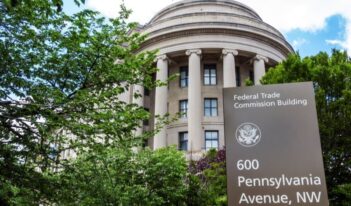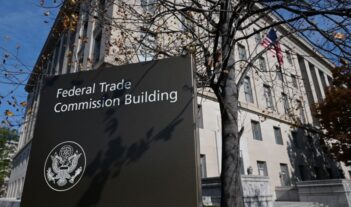
Walmart challenges the constitutionality of the FTC’s power to seek monetary or injunctive relief.
Article II of the U.S. Constitution vests the executive power in a President of the United States. Again and again, the U.S. Supreme Court has reminded us of this constitutional arrangement in consequential rulings concerning the separation of powers. Yet, despite the Court’s grand pronouncements, the relief obtained by litigants in recent separation-of-powers cases has been underwhelming at best.
Enter Walmart. In a recently filed motion to dismiss a U.S. Federal Trade Commission (FTC) lawsuit against the company, Walmart may have demonstrated how to thread the remedial needle in separation-of-powers litigation. The retail giant’s creative litigation strategy has set up a constitutional showdown with the FTC that might have some practical consequences.
The FTC recently sued Walmart under the FTC Act and the Telemarketing Act, seeking permanent injunctive relief, monetary relief, and civil penalties. The FTC alleges that Walmart has, for a while, knowingly processed “fraud-induced money transfers at its stores—funding telemarketing and other scams—without adopting policies and practices that effectively detect and prevent these transfers.” The case is pending in federal court in the Northern District of Illinois.
Walmart responded with a motion to dismiss, addressing the substance of the FTC’s claims. But the retail giant starts off its motion with a constitutional challenge, taking the position that the FTC “lacks constitutionally valid authority to initiate litigation seeking monetary or injunctive relief.”
The crux of Walmart’s argument is that because the FTC is organized as an independent commission—meaning that the President may not remove its commissioners at will—the U.S. Congress cannot furnish the commission with the power to bring lawsuits against private persons in federal court. Walmart therefore asks that the court declare that the FTC’s litigation powers are unconstitutional.
The FTC’s structure has long been the bugaboo of many executive power hawks. Congress set up the agency in 1914, insulating its commissioners from at-will presidential removal by establishing a requirement that FTC commissioners may only be fired for cause.
A few years later, in Myers v. United States, the Court explained that the general rule for removal is that the President possesses unrestricted removal power over executive officials. If the President could not exercise unrestricted removal power across the board, some of the executive power may in practice become vested in other officials—ones with tenure protection—and the President might be unable to “take Care that the Laws be faithfully executed.” This arrangement would present difficulties under Article II of the Constitution.
In 1935, the Supreme Court qualified the rule. That year, the Court decided Humphrey’s Executor v. United States and concluded that the congressionally enacted for-cause removal protections for FTC commissioners did not violate the Constitution. Just two years ago, in Seila Law v. CFPB, the Court acknowledged Humphrey’s Executor’s holding as an exception to “the President’s unrestricted removal power.”
But in its motion to dismiss, Walmart notes something important: The FTC in 1935 had different powers than it does today.
The Court in Humphrey’s Executor saw the FTC as a commission with duties that were “neither political nor executive, but predominantly quasi-judicial and quasi-legislative,” justifying the removal restrictions. As the Court noted in Seila Law, the Humphrey’s Executor Court mostly viewed the FTC as agency that merely performed certain legislative or judicial duties, such as sending reports to Congress and making recommendations to courts.
The modern FTC is quite different in character. The agency’s complaint against Walmart serves as a perfect demonstration of how different the modern FTC’s powers are. As Walmart points out, decades after Humphrey’s Executor, congressional enactments in the 1970s gave the FTC power to seek monetary relief and permanent injunctive relief through litigation. And here, the FTC flexes those powers, requesting an injunction and civil penalties against a private entity.
Walmart has these statutory provisions in its crosshairs, not the FTC commissioners’ removal protections. Unlike preparing reports for Congress or recommending dispositions to courts, the power to sue private parties for monetary relief is a “quintessentially executive power” that the Court did not consider in Humphrey’s Executor.
In recent years, the usual strategy in cases like this one has been to ask that a court declare that a certain executive official’s removal protections are unconstitutional. But in this filing, Walmart does not challenge—at least for now—Humphrey’s Executor’s finding that the FTC removal protections pass constitutional muster. Rather, the company argues that the new powers that Congress has granted the FTC in the intervening years since Humphrey’s Executor violate Article II.
According to Walmart, if Congress sets up an independent agency, it cannot then vest executive power in that agency. The agency must remain quasi-legislative and quasi-judicial. Instead of ruling in a way that is inconsistent with Humphrey’s Executor, a court could declare that the litigation power provisions are unconstitutional without contravening Supreme Court precedent. Professor Jennifer Mascott of Scalia Law School has filed a terrific amicus brief in the case, delving more deeply into the remedial question of what courts do when “two statutory provisions become unconstitutional only when they operate together.”
At bottom, if Walmart prevails here, the FTC cannot sue it. It is as simple as that. And that potential result is worlds different from one in which the FTC maintains its power to sue Walmart, subject simply to presidential removal of its commissioner.
Kudos to Walmart’s legal team for getting creative in its motion to dismiss. As Aaron Nielson, a professor at Brigham Young University Law School, has written: “This litigation is one to watch.”




